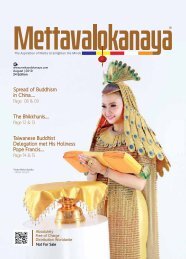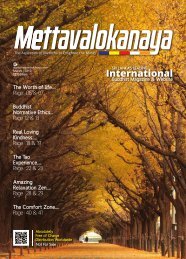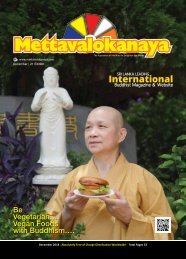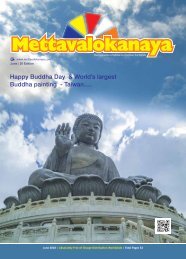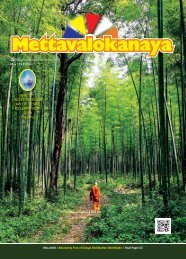mettavalokanaya_international_buddhist_magazine_january_2020
This is the Sri Lankan's Most Popular & Leading Monthly International Buddhist Magazine, “Mettavalokanaya” on January - 2020 Edition - 28. “Mettavalokanaya” International Buddhist Magazine has been successfully distributed to 40 countries worldwide. Specially distributed to Overseas High Buddhist Monks, Masters, Nuns, Worldwide famous Buddhist Monasteries & Associations, International Buddhist conferences and Forums. “Mettavalokanaya” International Monthly Buddhist Magazine has been awarded as the “2018 - The Global Buddhist Ambassador Award” from Thailand as the World’s Best and Most popular Buddhist Magazine. The Mettavalokana Buddhist Publications Centre is a registered Buddhist Publications Centre in Sri Lanka and has received many International accolades. Our publications are absolutely free of charge to general public. The magazine comprises of special articles on Buddhism written by leading Buddhist Monks from foreign countries. “Mettavalokanaya” is currently been published in English and includes full color 52 pages.
This is the Sri Lankan's Most Popular & Leading Monthly International Buddhist Magazine, “Mettavalokanaya” on January - 2020 Edition - 28. “Mettavalokanaya” International Buddhist Magazine has been successfully distributed to 40 countries worldwide. Specially distributed to Overseas High Buddhist Monks, Masters, Nuns, Worldwide famous Buddhist Monasteries & Associations, International Buddhist conferences and Forums. “Mettavalokanaya” International Monthly Buddhist Magazine has been awarded as the “2018 - The Global Buddhist Ambassador Award” from Thailand as the World’s Best and Most popular Buddhist Magazine. The Mettavalokana Buddhist Publications Centre is a registered Buddhist Publications Centre in Sri Lanka and has received many International accolades. Our publications are absolutely free of charge to general public. The magazine comprises of special articles on Buddhism written by leading Buddhist Monks from foreign countries. “Mettavalokanaya” is currently been published in English and includes full color 52 pages.
You also want an ePaper? Increase the reach of your titles
YUMPU automatically turns print PDFs into web optimized ePapers that Google loves.
Banka
Lungshan
Temple
Amazing
Values for
Buddhist’s
World….
Banka was renamed “Wanhua” in
accordance with the Japanese
pronunciation of the term as an
adjustment by the administration
system during the Japanese rule.
President of Lung Shan
Temple of Taiwan &
Vice President of World
Fellowship of Buddhists.
Dr. Steven S. W. Huang
Taiwan
Originally, it was the transliteration
of “Banka,” which is in the Ketagalan
language of the Pingpu tribe, meaning
canoe. At the time, the folks of the Pingpu
tribe sailed along the Danshui River on
canoes to transport sweet potatoes and
other farm produce in order to trade
with the Han Chinese.
In the past, the Han Chinese
migrated to and explored Taiwan by
sailing across the Taiwan Strait. The
waves were strong and the torrents
were great at sea. From time to time,
shipwrecks occurred. In addition, Taiwan
was an unexplored and nasty place
with a dangerous environment. In 1709
(during the reign of Emperor Kangxi),
Chen, Lai, Zhang Exploration Company,
formed by people from three counties
in Quanzhou (namely Jinan, Nanan
and Huian) and Tongan, obtained a
permit from the government to explore
the island. They began to explore the
Taipei Basin systematically. Later on,
people from the three other counties
migrated to Taiwan as well. Along with
them, they carried the incense pouch
from the temple of their hometown to
seek the deities’ blessings. Gradually,
a settlement was formed in Banka. In
1738 (the reign of Emperor Qianlong),
they requested the Guanyin Bodhisattva
of the Lungshan Temple in Jinan, Fujian
to divide her spirit then they carried it
to Taiwan. Worshippers raised funds to
build the Banka Lungshan Temple.
The Banka Lungshan Temple was
refurbished in 1815 (the reign of Emperor
Jiaqing) after a major earthquake. In
1867 (the reign of Emperor Tongzhi),
it was refurbished again after it was
damaged by a rainstorm. In 1919 (the
reign of Taisho of Japan), the beams and
pillars were eaten by termites, so Monk
Fuzhi, abbot of the temple, raised funds
to rebuild the temple. He took the lead
and donated all of his savings, about
7000 dollars, to rebuild it. This helped
shape the look of the Lungshan Temple
that we have now. In 1945, the temple
was damaged during WWII and the Main
hall was totally ruined. However, the
statue of Guanyin Bodhisattva was still
sitting on the lotus seat solemnly. In the
past, when there was an air raid, people
would seek refuge under the goddess’s
lotus seat. Since then, the goddess’
power and grace became known to
people. The motifs of the engravings
were mainly taken from the Romance of
the Three Kingdoms and Investiture of
the Gods.
Banka Lungshan Temple current
president is Dr. Steven S. W. Huang,
President of Lung Shan temple of Taiwan
& Vice President of World Fellowship of
Buddhists. He is the Professor of Chinese
Cultural University, Taiwan. National
Parliament and Congressman of Taiwan
for 10 years. Banka Lungshan Temple
includes, Guanyin Bodhisattva / Mañjuśrī
/ Samantabhadra / Skanda / Samghārāma
/ Eighteen Arhats / Da Kui Xingjun /
Wenchang Dijun / Ma Ye / Ziyang Fuzi /
Fudezhengshen / Chenghuang Ye / Long
Ye / Shuixian Zunwang / Taiyang Xingjun
/ Tianshang Shengmu / Taiyin Xingjun /
Zhusheng Niang Niang / Chitou Furen
/ Shier Pozhe / Sanguan Dadi / Guan
Sheng Di Jun / Ksitigarbha Bodhisattva /
Yuelao Shenjun / Huatuo Xianshi.
艋 舺 , 於 日 治 時 期 的 改 正 制 度 中 以 同 音
日 本 語 改 寫 成 「 萬 華 」, 原 為 平 埔 族 凱 達 格 蘭
語 Banka 的 音 譯 , 意 為 獨 木 舟 , 乃 當 時 平 埔 族
人 以 獨 木 舟 自 淡 水 河 上 游 載 運 蕃 薯 等 農 產 品 與
漢 人 交 易 因 而 稱 之 。 昔 漢 人 至 臺 拓 墾 , 乘 船 渡
越 臺 灣 海 峽 , 其 風 浪 強 勁 , 海 流 湍 急 , 時 有 翻
船 喪 生 變 故 , 加 上 早 期 臺 灣 北 部 乃 一 未 開 發 蠻
煙 瘴 癘 之 地 , 環 境 險 惡 。 清 康 熙 48 年 ( 西 元
1709 年 ), 由 泉 州 三 邑 人 ( 晉 江 、 南 安 、 惠 安
三 縣 合 稱 三 邑 ) 及 同 安 人 共 同 組 成 的 「 陳 賴 章
墾 號 」 取 得 官 方 許 可 , 有 組 織 的 開 墾 臺 北 盆 地
後 , 陸 續 有 其 他 三 邑 人 士 渡 海 來 此 , 並 攜 帶 原
鄉 廟 宇 香 火 袋 以 祈 神 佑 。 在 艋 舺 地 區 漸 成 聚 落
後 , 於 乾 隆 3 年 (1738) 迎 請 福 建 省 晉 江 縣 安
海 龍 山 寺 觀 世 音 菩 薩 分 靈 , 合 資 興 建 艋 舺 龍 山
寺 。
正 殿 屋 頂 則 採 歇 山 重 簷 式 , 四 面 走 馬 廊
共 四 十 二 根 柱 子 構 成 , 殿 外 牆 堵 留 有 多 幅 著 名
書 法 家 石 刻 ; 殿 內 的 螺 旋 藻 井 不 費 一 釘 一 鐵 ,
全 由 斗 栱 相 嵌 築 構 而 成 。 後 殿 屋 頂 亦 為 歇 山 重
簷 式 , 兩 翼 為 硬 山 單 簷 , 屋 脊 為 財 子 壽 泥 塑 剪
黏 , 為 典 型 儒 、 道 教 諸 神 佛 供 奉 處 。 左 右 護 龍
各 配 有 鐘 樓 與 鼓 樓 , 晨 鐘 暮 鼓 , 採 用 轎 頂 式 扁
六 角 形 屋 頂 , 造 形 獨 特 , 全 臺 首 見 。 全 寺 屋 頂
脊 帶 和 飛 簷 由 龍 鳳 、 麒 麟 等 吉 祥 物 造 形 , 飾 以
剪 黏 和 交 趾 陶 , 色 彩 瑰 麗 , 堪 稱 臺 灣 剪 黏 藝 術
之 精 華 。 艋 舺 龍 山 寺 於 民 國 107 年 升 格 為 國 定 古
蹟 , 身 為 臺 北 市 重 要 的 信 仰 中 心 , 艋 舺 龍 山 寺
除 持 續 加 強 古 蹟 維 護 外 , 每 年 定 期 舉 辦 傳 統 節
慶 祭 典 及 民 俗 活 動 , 如 農 曆 正 月 花 燈 展 覽 、 四
月 浴 佛 節 , 以 及 於 民 國 102 年 登 錄 為 無 形 文 化 資
產 的 中 元 盂 蘭 盆 勝 會 等 , 同 時 亦 定 期 辦 理 各 大
專 院 校 獎 學 金 , 認 助 清 寒 學 生 助 學 金 , 不 定 期
舉 辦 冬 令 救 濟 、 急 難 救 助 、 捐 贈 消 防 車 及 各 類
消 防 器 材 、 復 康 巴 士 。 民 國 94 年 再 於 板 橋 文 化
路 興 建 文 化 廣 場 大 樓 , 舉 辦 佛 學 講 座 、 各 類 藝
文 活 動 、 社 教 研 習 班 , 編 印 季 刊 及 農 民 曆 等 ,
並 持 續 推 動 公 益 慈 善 事 業 , 以 善 盡 宗 教 弘 法 利
生 , 淨 化 人 心 , 福 利 社 會 大 眾 之 宗 旨 。
“Pay respects to
the Buddha and
Bodhisattva”….
22 l Mettavalokanaya l January l 2020 l www.mettavalokanaya.com www.mettavalokanaya.com l 2020 January l Mettavalokanaya l 23











